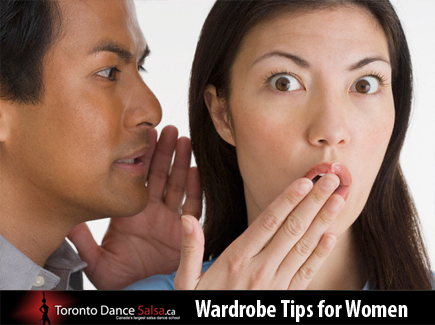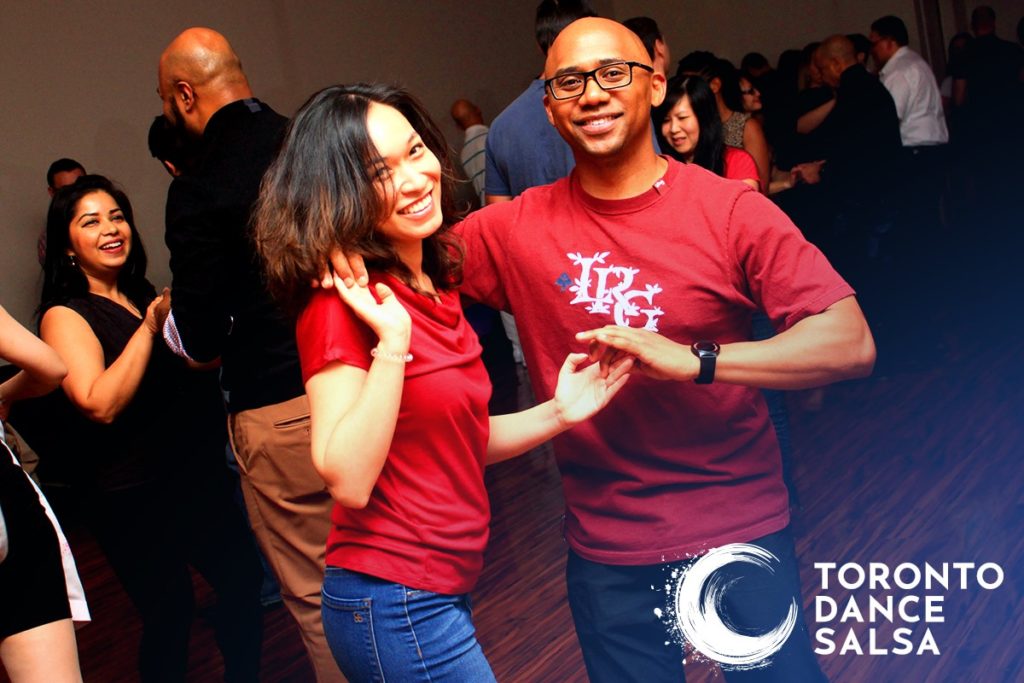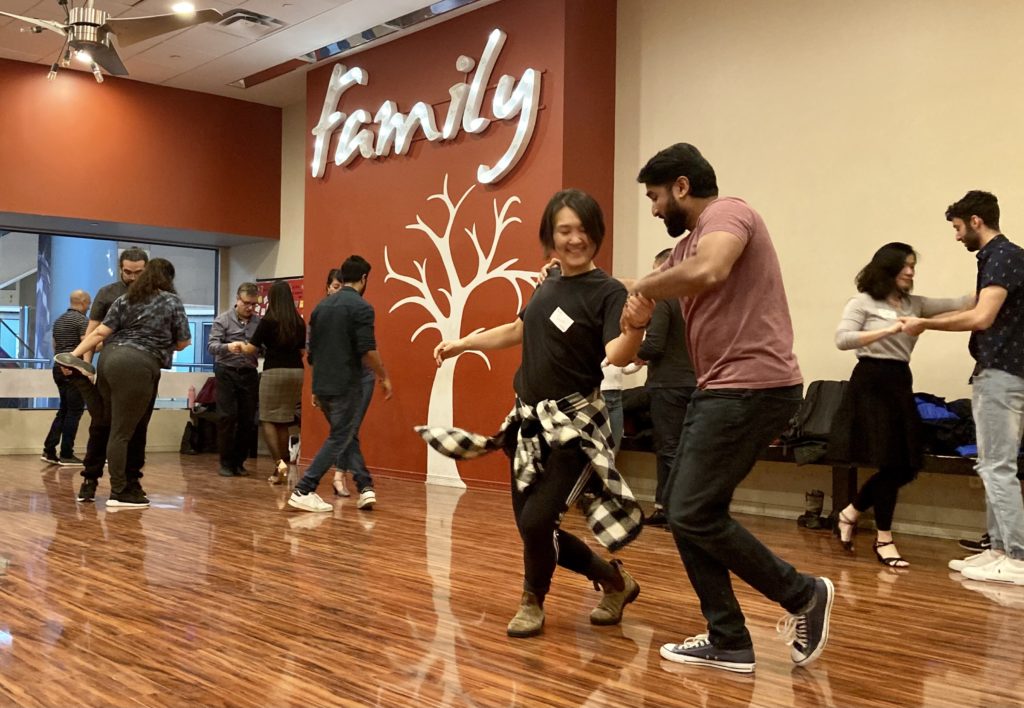“Once you become really addicted to Salsa you might want to start thinking about organizing your closet into “Salsa friendly” clothing.”
When you first start salsa dancing be ready to work up a sweat in class. Learning something new causes your brain and body to heat up and you’ll definitely start to get warm as your class progresses, so for studio classes it’s best to wear clothing that you can move around in (i.e., not too tight and not too warm) and layers are best.
For social dancing you can pretty much wear whatever you want to, you’re not only at a club to dance, but you’re there to socialize as well, so you might as well wear something you look and feel good in. Having said that, once you become really addicted to Salsa you might want to start thinking about organizing your closet into “Salsa friendly” clothing.
In terms of shoes you don’t have to purchase special dance shoes for your first set of classes. You should wear regular street shoes that are comfortable and have slippery soles such as smooth leather or plastic. Once you’ve completed a beginner/Level 1 course you should think about purchasing dance shoes. Dance shoes can cost anywhere from $60 to $200 a pair (depending on the make and materials of the shoe) but are a good investment as dance shoes are specially shaped and manufactured for smooth movement on the dance floor and proper foot support. Dance shoes are more light-weight than regular street shoes, and with proper care and maintenance, a good pair will last you from 6-12 months (if you dance consistently).

In the studio:
The best is a simple tee and jeans or what you’d wear to a yoga class: something comfortable and in fabrics that will allow your skin to breathe.
At the club:
Dressier tee shirts and jeans that are made of thinner and lightweight fabrics (or fabric that wicks away sweat). Also, bringing an extra shirt or two to change into midway through the night is really helpful (and highly recommended).
Shoe options for men:
Dance sneakers
These are the most popular options for men. Companies like Ballo and Jinga produce stylish shoes for men (they most resemble the look of a Puma sneaker) and come in a variety of colours and styles. These shoes can have a suede or a smooth rubber sole that make it easy to spin and move on the dance floor, but also are “sporty” enough to resemble a street shoe so guys don’t feel like their wearing an “obvious” dance shoe.
Jazz Sneakers
A great shoe for complete beginners or for practice. These shoes provide great arch support and the plastic split soles are good for spinning and the added cushioning is very comfortable. Bloch and Capezio both produce good jazz sneakers.
Jazz Slippers
Like the name implies, these shoes are made of supple leather that fits like a slipper and come in slip on or lace up versions. Some slippers have a suede sole which is more suitable for multiple turns. Others have a plastic split sole (like sneakers) which is easier to maintain but not as easy to spin with.
Ballroom shoes
Ballroom shoes are the most formal salsa footwear and have suede soles which need to be brushed after every usage to maintain their quality. Men’s ballroom shoes have a Cuban heel that can be 1″, 1.5″ or 2″ in height – these shoes are geared towards more formal dance venues and events (i.e., performance) and are generally not very popular in the salsa scene.

In the studio:
It’s best to wear something form fitting (i.e., not too loose as clothing that shifts around can cause “wardrobe malfunctions” during turn patterns). Also be sure to wear shorts or pants, especially if you’re in a higher level or specialty dance class – you can never be sure when dips or tricks will be taught in a class and a skirt or dress might make it difficult to execute more complicated moves or leg styling.
At the club:
Tops that “stay put” and shorts or pants in light-weight fabrics. Skirts and dresses are also great but be sure to do the “Salsa spin” test before going out to dance – make sure the skirt or dress stays “down” when you spin, turn and style. Dresses that are too long, too flowy or too tight are not ideal for dancing as there is not much opportunity for adjustment or “wardrobe checks” once you’re in the middle of a dance.
Shoe options for women:
Ballroom shoes
The popular option for women are Ballroom or Salsa shoes. They are the most formal salsa footwear and have suede soles which need to be brushed after every usage to maintain their quality and are made with special arch support and cushioning. Women prefer Ballroom/Salsa shoes to any other dance shoe because they come in the most versatile styles and can go with pretty much any outfit. If you are a new dancer it’s best to choose a heel height of 1.5″ to 2″. More experienced dancers prefer heels of 3″-4″ but be mindful that higher heel heights can be painful to dance in for a full night of dancing if you’re not use to dancing in heels.
There are a number of shoe companies that make beautiful Salsa dance shoes – Burju and Natural Spin both make beautiful and stylish Salsa shoes, with companies like Capezio and SupaDance making more traditional ballroom styles.
Jazz Sneakers
A great shoe for complete beginners or for practice. These shoes provide great arch support and the plastic split soles are good for spinning and the added cushioning is very comfortable. Bloch and Capezio both produce good jazz sneakers.
Jazz Slippers
Like the name implies, these shoes are made of supple leather that fits like a slipper and come in slip on or lace up versions. Some slippers have a suede sole which is more suitable for multiple turns. Others have a plastic split sole (like sneakers) which is easier to maintain but not as easy to spin with.
I cannot wait to welcome you with a high five, a big hug and have you join Toronto Dance Salsa. Click here to check our current schedule.
There are so many other tips I can give and I would love to hear from you. If there is a post you want me to write about, please get in touch with me through Instagram (torontodancesalsa), Twitter (#torontodancesalsa), Facebook (Toronto Dance Salsa) or email [email protected].


